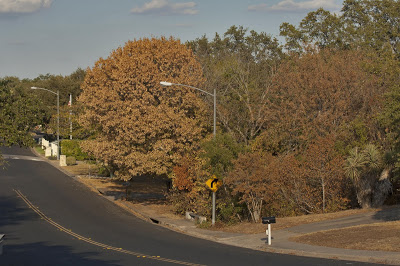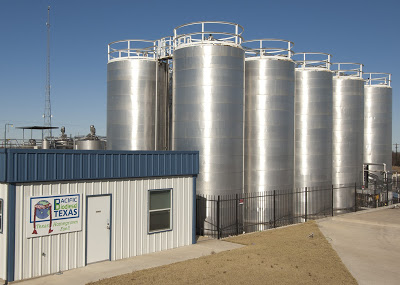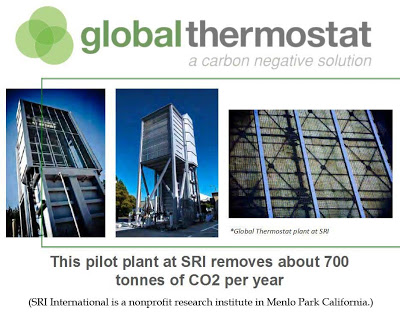What is to be done?
Welcome to climate change in Texas / 3
By Bruce Melton / The Rag Blog / January 11, 2012
[This is the third in a three-part series.]
AUSTIN — The Texas Forest Service tells us that a half billion trees are dead across Texas. The drought and heat that killed them was similar to the heat wave in Moscow (central western Russia) in 2010 that killed 56,000 and created $15 billion (US dollars) in damages. Academic evaluation of the (Russian) event shows it was 80 percent caused by climate change.
Damage to agriculture and from the drought tops $10 billion here in Texas with another billion and a half in fire damages. Thankfully, the deaths were not nearly as high here because of the predominance of air conditioning in the drought area in Texas and the Southwest.
As I have been saying in the first two installments of this series, climate change is already much more extreme than most scientists have been predicting. This is mainly because the majority of predictions are based on the “most likely” emissions scenario and because we have not reduced our emissions like climate scientists told us to do we are now on the worst-case emissions scenario path.
The bad comes with good though. The solutions to climate change are going to be much less difficult and costly than have been popularized. I will get to the cost and difficulty aspect in a minute but first: one of the biggest reasons that climate change is much more extreme than we thought it would be is that almost all of the predictions have been based on the “most likely scenario.” This “most likely scenario” is just one of about 28 computer scenarios that climate scientists use in dozens of different climate models to look into the future.
The “most likely scenario” — sometimes known as the “middle of the road scenario” — is roughly based on Kyoto. In other words, if we would have started reducing our greenhouse gas emissions when the consensus of scientific knowledge said we should, these droughts and heat waves would not have happened.
Climate scientists began warning us in the mid-1970s about dangerous climate changes if we don’t control our emissions levels. By the time the Rio Earth Summit happened, the modelers knew that the safe zone was likely one with a carbon dioxide concentration similar to that of
the 1980s at the most.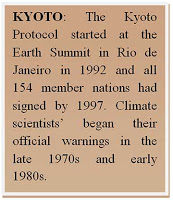
Instead of listening and acting though, our emissions have grown 50 percent greater than 1990 levels. And unexpectedly, in 2011 (climate scientists warn us that these unexpected things will happen more frequently) annual global emissions rose to six percent — a level not seen since 1970. This is why we are on the worst-case scenario path.
Along this path we should expect weather to be much more extreme. We are nearing the point where our already-changed climate could be considered dangerous; maybe we have passed it.
The links to climate change are being made in the scholarly findings at an increasing rate. A summary of such works prepared by Kevin Trenberth and a roster of distinguished colleagues summarizes 61 scholarly findings since the turn of the 21st century. The conclusion of the paper reads:
Human-induced climate change has contributed to changing patterns of extreme weather across the globe, from longer and hotter heat waves to heavier rains. From a broad perspective, all weather events are now connected to climate change. While natural variability continues to play a key role in extreme weather, climate change has shifted the odds and changed the natural limits, making certain types of extreme weather more frequent and more intense.
It is no longer valid to say that we cannot blame any one individual weather event on climate change. From statistical evaluation of historic weather events to the results projected from computer climate models our scientists can now say that climate change is to blame for the ultra-extreme weather we have been having.
The models show that without our climate having changed already, the costly snowtastrophes in the Northeast and northern Europe would not have happened; billions of trees would not have died in the Rockies because of a native beetle infestation gone berserk; billions of trees would not have died in the Alaskan boreal forest because of extreme fires caused by warming; and billions of trees would not have died in the Amazon because of drought — the results being annual greenhouse gas emissions from the Amazon alone equal to three-quarters of annual U.S. emissions.
Part of the reason that climate scientists can say this with certainty is that their computer models include these unprecedented events, whereas when they run the models without the extra greenhouse gases emitted by our civilization, these unprecedented events do not appear.
How do the scientists know their models are accurate when weather forecasting models so often fail after only four or five days? Climate models show us that they are much more accurate than weather models because climate scientists can start them up in the ancient past and recreate climate faithfully according to evidence from ocean and lake sediments, ice cores, stalagmites, tree rings, pollen records, fossil shells, soil carbon.
But climate models and weather models are basically the same aren’t they? Yes they are, but climate modelers run dozens of models for hundreds or thousands of years with varying input criteria and average the results all together to get climate. (These are called ensembles.)
The key here is that climate modelers average their results of many different model runs together. Weather forecasting models used by meteorologists in what is in reality a very different field of science than climate, only run one or a few models and then hope that by the fifth day the chaos has not left their seven day forecast in shambles. The two modeling techniques could hardly be more different. For climate, the averaging of so many different model running together makes the chaos (or inaccuracy) of weather models moot.
Our climate scientists have known since the beginning that climate change could certainly be as bad as it is now; this was evident from the results of their worst-case scenario model runs as well as the vast amount of evidence of radically abrupt climate changes in ancient history. To prevent these worst-case impacts from happening though, climate scientists expected us to take their sage advice and do something.
Instead we have done almost nothing. But with this realization we must understand that our innocence in this affair is real. The counterintuitiveness of climate change alone is enough to create a great debate, never mind the doubt spread by vested interests in the form of negative false propaganda about climate science, and even personal attacks against individual scientists.
These tactics are virtually identical to past deceitful propaganda campaigns concerning acid rain, ozone-depleting chemicals, pesticide reform, and smoking. In many cases these campaigns were perpetrated by the same institutions and individuals who are attacking climate science today.
So our climate scientists said that if we did nothing, things would be much worse, that our bread basket regions would change to deserts, that wildland fires would increase dramatically, deaths from heat would skyrocket, insect infestations would cripple ecosystems, feedback mechanisms would kick in and there would be war over resources. They told us these things would happen much sooner if we did nothing, whereas if we reduced our emissions we could likely forego these things altogether.
Surprise! All of this has now happened or is in progress. We did nothing and our emissions path is along the worst-case scenario. Civil war in Somalia has been the latest to be added to the lists of things that have been caused by climate change; so said the head of the African Development Bank last August.
Climate scientists have been telling us for a long time, and they continue to warn today, that it will get worse faster. They are now telling us that the threshold to dangerous climate change is no longer 2 degrees C of warming, but 1 degree C. Two degrees should now be considered the threshold to extremely dangerous climate change.
The 2001 IPCC report told us that 550 ppm CO2 was the safe limit in our atmosphere to hold our temperature down to 2 degrees C of warming. The 2007 IPCC report pushed that down to 450 ppm. Since the 2007 IPCC report, some of the most distinguished scientists in the world have been telling us that 350 ppm CO2 is the safe limit and now, the latest papers from the scholarly journals tell us that 300 ppm may be the safe limit. (We are currently at about 392 ppm and in preindustrial times it was about 280 ppm.)
Why? Because we didn’t do what the climate scientists told us we should do. We are on the wrong path.
What we are seeing across the globe today with these unprecedented and extreme weather events is the beginning of dangerous climate change. It is now indisputable and if we do not act fast, impacts will be unimaginable. Which leads me to my second message from the world of academia:

Fixing our climate will be no more difficult than installing toilets across the world like we have done over about the last 100 years. It will cost no more, and in what is becoming an indisputable truth, it will be vastly profitable for our society.
Why is this message so different from the one we have all heard? The answer rolls back to those moneyed interests and their propaganda. A few simple statements explain this conundrum clearly: The same voices that simultaneously bring us the radically different and designed to be confusing talking points — that climate change is not real, that it is all just a natural cycle, that it is a scientific conspiracy and that it will be good for us — are the same voices that tell us that the solutions to climate change will ruin our economies.
It is very simple. Not only are these voices telling us all of these vastly conflicting things at the same time, but they were wrong about the causes and effects of climate change. So given the conflict, and the accuracy of these voices and their “beliefs” about the sciences of climate, why would their “beliefs” about the solutions to the climate crisis be any less wrong?
Climate scientists are saying nothing about the solutions ruining our economies. The academic evaluations of the economics of the solutions to climate change do not tell us anything like what is so prevalent in the public’s understanding.
All of this darned propaganda and counterintuitivity is blotting out the truth. The climate scientists do not have the resources to mount an outreach campaign anywhere close to the size and extent needed to counter the efforts by the “voices.”
The most current assessments of the cost and scope of fixing our out-of-control climate tell us that it will take about one percent of global Gross Domestic Product (GDP) per year for a hundred years to create the infrastructure needed to clean up our greenhouse gas pollution. This is very similar to the installed costs of toilets and wastewater collection and treatment systems around the world today.
Now listen up: it took me weeks for the reality of this statement to set in. Climate scientists are telling us that the solutions to the climate crisis are not really so different from the solutions to the toilet crisis.
Another excellent example of the scope of the challenge ahead is the Great Wall of China. Our civilization has built many things of the scope of what needs to be built to remove our greenhouse gas pollutants from our atmosphere. If it is hard to visualize all of the toilets, pipes and treatment plants, it is not too hard to visualize the Great Wall of China.
A few simple chemical processes, based on those that are widespread in industry today and simpler than that used to create biodiesel, would be all that is needed. The technology is officially called air capture and mineral sequestration and it is really nothing more than mining carbon from the sky.
Think of thousands and thousands of railroad boxcars lined up end to end, something the size of the Great Wall of China (which was built by hand, over several different periods, totaling much less than a hundred years). Each one of these boxcar-sized processes would capture CO2 directly from the atmosphere.
A couple of scientists from Columbia University, and Gary Comer’s foundation (Gary Comer was the founder of Land’s End), have developed and scale-tested a process to do just this. Another outfit called Carbon Engineering has done the same thing. Another called Global Thermostat has done the same. What’s more, these technologies can very easily be retrofitted onto existing coal-fired power plants or industrial processes creating a sequestration solution much less expensive than what ongoing developments in the energy industry suggest.
All of these individual boxcar-sized processes, in another example, are probably no larger than the size of all of the chemical plant installations at the Ship Channel complex in Houston. These facilities could remove half of the total carbon dioxide emissions created by all of us earthlings every year.
(Why half? Efficiency gains and carbon source capture at power plants can be done, but point source capture from all transportation sources, or energy lost due to inefficient buildings, cannot yet be done on this planet. We must use air capture if we are to get our CO2 emissions down anywhere below about 50 percent of what we emit. This is a very simple piece of the puzzle that is taken into consideration almost exclusively by the politics of climate science.)
The final costs would be far, far less than the cost of building all of the coal-fired power plants on Earth alone, much less the vast network of hundreds of thousands of miles of power lines used to distribute the energy that we needed to achieve the greatness of our civilization.
Another comparison would be that the total disposal costs of all of this CO2 pollution would be far, far less than what were required to build all of our roads and gas stations.
But, what about that two-year study by the American Physical Society (APS) last summer? The press release, not typical of the Massachusetts Institute of Technology, called our air capture scientists “snake-oil salesman.” The APS’s widely publicized findings appear to show that air capture is actually 20 times more expensive than the air capture “snake-oil salesman” would have us believe (the press release actually said that.)
So the public now understands that air capture snake-oil salesman now have no more credibility than some product on the shopping network that promises to be both a floor polish and desert topping. At least, this is the reporting we get from the conservatively controlled megamedia conglomerates and from the “voices” that would have us believe that climate change is simultaneously “not real,” a “conspiracy,” and “good for the planet.”
What “voices” and the media do not tell us however is that the APS study simply did not look at any processes other than traditional ones — and the authors of the study tell us so. The study also falsely leads us to believe that there are no current pilot processes in existence, an observation easily countered with a quick Googling of the subject.
What the study should possibly have said is that there are no pilot study processes in existence that use the traditional costly process that they evaluated. The traditional processes use giant fans to move air, highly caustic lye or expensive synthetic chemicals to capture CO2 and 350 to 800 degrees of heat to regenerate the capture chemicals.
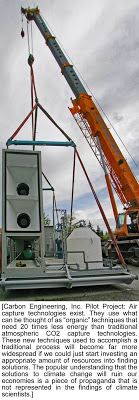 The alternatives used in the actual pilot processes already constructed and proven in the field often use the wind for moving air, require chemicals that are much less caustic and use room temperature reactions, or temperatures less than the boiling point of water to regenerate the absorbing materials.
The alternatives used in the actual pilot processes already constructed and proven in the field often use the wind for moving air, require chemicals that are much less caustic and use room temperature reactions, or temperatures less than the boiling point of water to regenerate the absorbing materials.
The Lackner model, being developed by Kilimanjaro Energy, uses a simple everyday plastic material to absorb carbon dioxide and water to release the carbon dioxide from the plastic. These are all very simple ideas and they have been proven with scale tests to be affordable. The Lackner model for example costs about $30 to remove a ton of CO2 and this cost will likely fall drastically with massive industrialization.
So, just to be clear, why does this big two-year study tell us that the costs are $600 a ton? It is because the new air capture technologies have not been published in the peer review literature. The developers of these technologies are concerned that this would compromise their secret processes. The APS study simply looked at using the old highly caustic lye process, using big fans and 800 degree regeneration temperatures. But did the media tell us this? No. Did the “voices” tell us this? Certainly not!
There will be billions of dollars to be made from these processes in the very near future. Statoil in the North Sea has spent $80 million to build a plant to capture and inject supercooled quasi-liquid CO2 deep beneath the sediments of the North Sea to avoid a $50-a-ton carbon tax in Norway.
The CO2 is coming from natural gas Statoil is producing. The process sequesters a million tons of CO2 per year and its development and installation cost was paid back in less than two years. Another very important thing to remember is that Statoil uses the traditional expensive air capture process and 800 degree regeneration temperatures.
Once the CO2 is captured from the air it must be disposed of. How does one dispose of 10 gigatons of carbon every year? One of the best ways takes the solid carbonates collected with the new air capture techniques and piles them up in mountains at the collection site. This is an immense job, but one that is done every year at a coal mine near you.
In a little more detail, 10 gigatons of carbon turns into 30 gigatons of calcium carbonate or limestone. Changing carbon dioxide into limestone is also a much more permanent way to solve the problem than disposing of (or storing) the gas underground.
We mine seven gigatons of coal to feed our power plants every year. Much of this mining is from pits or mountaintops. The amount of rock and soil that must be removed to get to the coal is usually much more than the amount of coal mined itself, so the total amount of material moved is far larger than the seven gigatons that we mine. We would be coal unmining on a scale that at the most, is as large as the coal mining industry today.
A big job this certainly is, but comparing it to something known really gives us a sense that somewhere, somebody has been getting their facts confused. Another comparison is even simpler: Why don’t we visualize all of the CO2 pollution emitted by humans every year and compare it to all of the human waste pollution created every year? I am talking about those wastes from human bodily functions that go into our sinks and toilets and then miraculously and thankfully vanish from our lives.
The amount of carbon dioxide, converted to liquid that we emit globally every year would cover the island of Manhattan to the 85th floor of the Empire State Building. If we collected all of the toilet and other wastes that flow into our wastewater collection systems every year, just in the United States, the amount would be far above the top of the antenna on the Empire State building (eeeewe).
Real costs are hard to determine, sort-of like predicting the cost of wastewater treatment today as we sat in our outhouses a hundred years ago (eeeewe). The best knowledge we have though tells us that 25 to 50 cents per gallon of gas would do the trick. This would be $20 to $30 per ton of carbon. In the North Sea, Statoil has proven the feasibility and profitability of disposing of a million tons of CO2 a year to avoid Norway’s $50 a ton carbon tax which is equal to about 50 cents per gallon of gasoline.
Yet another example comes from one of the most important climate scientists of our times: Wallace Broecker at Columbia University. Broecker has been instrumental in explaining ocean current processes and their relationships to past abrupt climate changes.
Broecker is a great proponent of this process of mountaintop reinstallation called atmospheric capture and mineral sequestration. He says that if we used wind energy to substitute for coal, it would take an area of wind the size of a barn to provide enough electricity for the average family for a year.
Compare this to the cost of burning coal and then removing the carbon dioxide from the atmosphere. The amount of energy needed could be thought of as being the same as the wind can generate through a barn window! The cost is something near 170 times less!
My story has strayed a bit from the current climate change impacts in Texas, but the solutions to the climate change challenge are just as important as understanding that climate change is real, that it is happening now, and that it is happening along the lines of the worst-case scenario. The reason the solutions are so important is the broad assumption that the solutions will ruin our economies.
To understand why the propaganda has been able to so heavily influence society is a topic that I have barely skimmed, but is well documented in many books (see references) and articles (my own and many, many others) citing public tax records from the Internal Revenue Service showing who donated how much to what institutes supporting beliefs contrary to the consensus of climate scientists.
And once again, understand that the vast majority of folks supporting the non-climate change position base their beliefs on the positions of their authority figures. These good folks, including most of their authority figures, are innocent.
Our great innocence in this matter does not change reality though. We are polluting, but we are not paying. One percent of global GDP per year is what the scientists and economists are focusing on as the cost of fixing climate pollution.
Professor Richard Alley of Penn State and one of the coolest ice science geeks on the planet tells us there are about 100 economic assessments of the solutions now. One percent of GDP is about $600 billion a year, or about as much as the annual U.S. military budget — without wars. We simply need to help our leaders understand that the risks from climate change are at least as high as the risks from war. Having the courage to spend the money is easy once the real risks are known.
So make those calls and write those letters and talk with your friends and neighbors and get downtown and stand with the Occupy Movement. The only way to beat the propaganda, the counterintuitiveness, and the pure innocence of ignorance is through a groundswell of activism and a transfer of knowledge.
This is real, we are responsible, we must provide the solutions, the solutions are already devised and waiting for industrialization, and the costs and difficulty will be no greater than many other things our civilization has accomplished.
And always remember that these “easy” solutions to the climate change challenge do not give us the right to emit more pollution, any more than toilets and wastewater treatment systems give us the right to make more of that kind of pollution. One more thing: greenhouse gas pollution is very much like that “other” type of pollution. It is an intimate part of our lives and it will not go away by itself.
[Bruce Melton is a professional engineer, environmental researcher, filmmaker, writer, and front man for the band Climate Change. Information on Melton’s new book, Climate Discovery Chronicles, can be found, along with more climate change writing and outreach, critical environmental issue films, and the band’s original blues, rock, and folk music tuned to climate change lyrics at his website. Read more articles by Bruce Melton on The Rag Blog.]
- Listen to Thorne Dreyer’s December 30, 2011, Rag Radio interview with Bruce Melton.
Austin drought and fires, 2011:
Bruce’s summer vacation with climate change
References:
Moscow and European Heat Wave:
Rhamstorf and Coumou, Increase of extreme events in a warming world, PNAS, October 24, 2011.
http://www.pik-potsdam.de/~stefan/Publications/Nature/rahmstorf_coumou_2011.pdf
Worst-case scenario:
Synthesis Report, Climate Change, Global Risks, Challenges and Decisions, Climate Change Congress, International Alliance of Research Universities, University of Copenhagen, March 2009. http://climatecongress.ku.dk/pdf/synthesisreport
Raupach, et. al., Global and regional drivers of accelerating CO2 emissions, PNAS, April 2007.
http://www.pnas.org/content/104/24/10288.full.pdf+html
IPCC Special Report on Emissions Scenarios, http://www.ipcc.ch/ipccreports/sres/emission/index.htm
Six percent CO2 growth in 2010…
Carbon Dioxide Analysis Center. http://cdiac.ornl.gov/ftp/ndp030/global.1751_2008.ems
Sixty-one examples of climate changes already happening…
Trenberth et al., Current Extreme Weather and Climate Change, Climate Communication.org, Science and Outreach, September 2011. http://climatecommunication.org/new/articles/extreme-weather/overview/
Deceitful propaganda campaigns similar to acid rain, smoking, pesticides and ozone depleting chemicals…
Oreskes and Conway, Merchants of Doubt, Bloomsbury 2010.
Billion dollar U.S. weather disasters 2011, National Climatic Data Center
http://www.ncdc.noaa.gov/oa/reports/billionz.html
The cost of burning coal and removing the CO2 is 170 times less than wind energy…
Broecker and Wang, Fixing Climate: What Past Climate Changes Reveal About the Current Threat–and How to Counter It, Hill and Wang, 2009.
Snowtastrophes, beetle infestations, Alaskan fires, The Amazon:
References are too numerous to mention here but can be seen in individual discussions of these topics at my Climate Discoveries Chronicles webpage on www.meltonengineering.com
Vested interest propaganda:
Powell, The Inquisition of Climate Science, Columbia University Press, 2011.
Oreskes, Merchants of Doubt, Blomsbury, 2010.
Washington and Cook, Climate Change Denial, Rutledge, 2011.
Bradley, Global Warming and Political Intimidation: How Politicians Cracked Down on Scientists As the Earth Heated Up, University of Massachusetts Press, 2011.
Hoggan and Littlemore, Climate Cover-Up: The Crusade to Deny Global Warming, Greystone, 2009.
CO2 emissions are worse than the worst-case scenario developed by the IPCC:
Synthesis Report, Climate Change, Global Risks, Challenges and Decisions, Climate Change Congress, International Alliance of Research Universities, University of Copenhagen, March 2009. http://climatecongress.ku.dk/pdf/synthesisreport
Raupach, et. al., Global and regional drivers of accelrating CO2 emissions, PNAS, April 2007.
http://www.pnas.org/content/104/24/10288.full.pdf+html
IPCC Special Report on Emissions Scenarios
http://www.ipcc.ch/ipccreports/sres/emission/index.htm
Regions would change to deserts, wildland fires would increase dramatically, deaths from heat skyrocket, insect infestations would cripple ecosystems, feedback mechanisms would kick in and there would be war over resources: References are too numerous to mention here but can be seen in individual discussions of these topics at my Climate Discoveries Chronicles webpage on www.meltonengineering.com
2 Degrees C, 550, 450, 350 and 300 ppm CO2, Extremely dangerous climate change:
IPCC 2007, Contribution of Working Group III to the Fourth Assessment Report of the Intergovernmental Panel on Climate Change,, B. Metz, O.R. Davidson, P.R. Bosch, R. Dave, L.A. Meyer (eds), Cambridge University Press, Cambridge, United Kingdom and New York, NY, USA, Chapter 13, Policies, Instruments and Co-operative Arrangements.
Morrigan, Target Atmospheric GHG Concentrations Why Humanity Should Aim for 350 ppm CO2e, University of California Santa Barbara, 2010. http://www.global.ucsb.edu/climateproject/papers/
IPCC 2001, Intergovernmental Panel on Climate Change, Third Assessment Report, Climate Change 2001: The Scientific Basis, Technical Summary. http://www.grida.no/publications/other/ipcc_tar/
Ramanthan, On avoiding dangerous anthropogenic interference with the climate system: Formidable challenges ahead, Proceedings of the National Academy of Science of the Untied States of America, 2008. http://www.pnas.org/content/105/38/14245.full.pdf+html
Hansen et al., Target Atmospheric CO2 Where Should Humanity Aim, Open Atmospheric Science Journal, NASA, November 2008. http://pubs.giss.nasa.gov/abstracts/2008/Hansen_etal.html
The Toilet Crisis:
Alley, Earth: The Operators Manual, WW Norton, 2011.
Broecker and Wang, Fixing Climate: What Past Climate Changes Reveal About the Current Threat–and How to Counter It, Hill and Wang, 2009.
The costs of solutions to the climate crisis:
ibid.
American Physical Society Study:
Direct Air Capture of CO2 with Chemicals, The American Physical Society, June 2011.
http://www.aps.org/policy/reports/assessments/upload/dac2011.pdf
Evaluation of APS study by Nature:
http://blogs.nature.com/news/2011/05/sucking_carbon_dioxide_from_ai.html
Disposal of 10 gigatons of carbon:
Broecker and Wang, Fixing Climate: What Past Climate Changes Reveal About the Current Threat–and How to Counter It Hill and Wang, 2009.
Atmospheric capture, mineral sequestration and the barn:
ibid.
Additional research and development costs:
ibid.
About 100 economic assessments of the solutions to climate change:
Alley, Earth: The Operators Manual, WW Norton, 2011.

